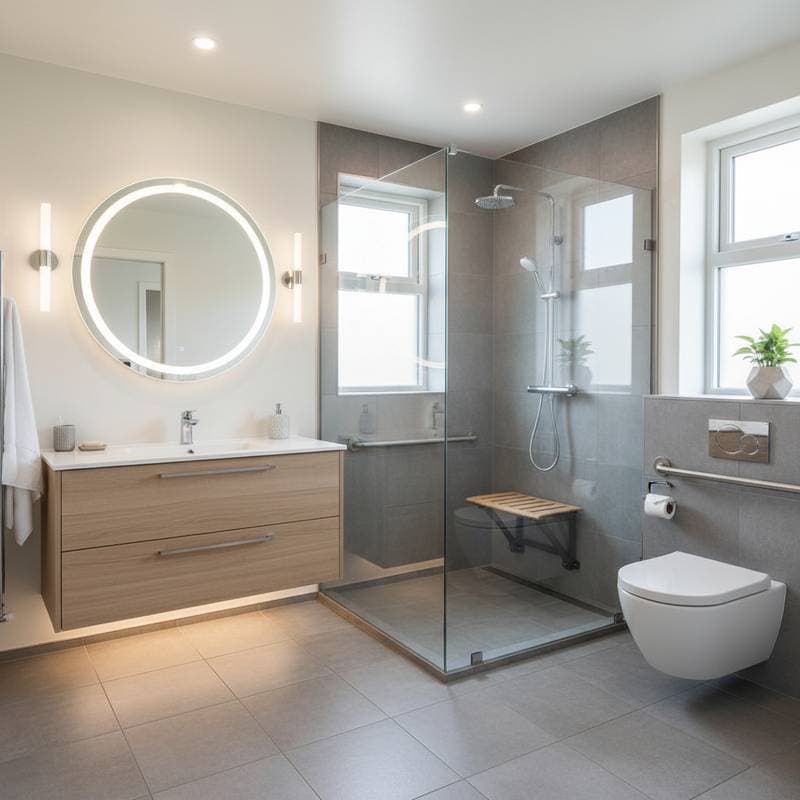Japandi Wet Rooms: 2025's Minimalist Luxury Trend
Serenity defines the Japandi wet room. This design approach merges Japanese simplicity with Scandinavian warmth to produce spaces that resemble private spas within the home. Clean lines, natural materials, and an overall sense of calm characterize the style. The approach accommodates any budget, whether through a complete bathroom remodel or a simple refresh.
What Makes Japandi Distinctive?
Japandi integrates the Japanese principle of wabi-sabi, which appreciates beauty in imperfection, with the Scandinavian notion of hygge, emphasizing comfort and coziness. The outcome yields a grounded, calm, and restorative environment. In a wet room, these elements unite effectively. Envision a bathroom where the shower, tub, and floor integrate seamlessly, every surface serves a purpose, and simplicity conveys luxury.
Professionals have observed this style enhance spaces from compact condominium bathrooms to expansive master suites. The key lies not in size or expense but in achieving balance. A Japandi wet room encourages individuals to pause, breathe deeply, and appreciate their surroundings.
Key Design Elements of Japandi Wet Rooms
Seamless Layouts
Wet rooms forgo conventional shower enclosures, permitting water to drain via a gentle floor slope. This open configuration expands the perceived space and imparts a modern aesthetic. Employ a uniform floor material across the room, such as large-format porcelain tiles or microcement. For limited budgets, vinyl sheet flooring with a matte stone appearance provides a comparable effect at reduced cost.
Natural Materials
Incorporate bamboo, stone, and light woods. A teak shower bench or light oak vanity introduces warmth to sleek tile surfaces. To replicate stone without high costs, select ceramic tiles that imitate limestone or slate. These options prove durable, simple to maintain, and economical.
Muted, Earthy Palettes
Japandi spaces favor understated colors. Soft grays, warm whites, and taupes form the primary palette. Introduce depth with charcoal or muted green accents. Painting represents the most straightforward and cost-effective update; a gallon of high-quality, moisture-resistant paint refreshes a bathroom for less than fifty dollars.
Minimal Fixtures
Choose sleek, understated hardware. Wall-mounted faucets, rainfall showerheads, and linear drains preserve a clean appearance. Matte black and brushed brass finishes complement the style. Designer fixtures prove unnecessary; major retailers offer Japandi-inspired options at reasonable prices.
Smart Storage
Clutter disrupts tranquility. Built-in niches, floating shelves, and hidden cabinets maintain focus on the design rather than items. A modest shower ledge accommodates soaps and candles, adding utility without interrupting the layout.
Lighting in Japandi Wet Rooms
Lighting plays a crucial role in Japandi wet rooms. Soft, diffused illumination highlights natural textures and fosters a serene spa ambiance. Layer lighting sources: ceiling fixtures for overall brightness, wall sconces for warmth, and concealed LED strips for subtle glow behind mirrors or beneath shelves. Dimmable bulbs facilitate transitions from morning task lighting to evening relaxation.
For a hands-on project, install adhesive LED strips under floating vanities to achieve a professional effect.
Infusing Warmth into Minimalism
A common misunderstanding portrays minimal design as cold. Japandi counters this through texture and tone. Introduce a linen shower curtain, woven baskets, or a soft cotton rug. A small potted plant further enhances the atmosphere.
On constrained budgets, prioritize accessories. Replace an existing bath mat with one made from natural fibers and incorporate wood elements to notice immediate improvements.
From television design expertise, tactile contrasts excel in both visual and practical contexts. Combine smooth tiles with ribbed wood or matte surfaces with slight gloss to create interest without excess.
Functionality and Innovation
Wet rooms combine aesthetics with practicality. They simplify cleaning and optimize space usage. In compact bathrooms, removing shower trays or doors doubles the sense of openness. During renovations, install a linear drain along one wall for an elegant, discreet result.
Without full renovations, establish a wet zone using a partial glass panel and consistent tiling; this weekend task elevates the space significantly.
Homeowners often discover wet rooms more attainable than anticipated, thanks to the concept's adaptability. Even small bathrooms capture Japandi essence through careful planning, emphasizing proportion and restraint.
Balancing Tradition and Modern Comfort
Japandi wet rooms honor craftsmanship. Seek handmade tiles, joinery revealing wood grain, or fixtures with an artisanal quality over mass production. The style also welcomes contemporary features like heated floors, smart mirrors, and water-efficient systems.
The objective merges timeless serenity with modern ease. Both elements coexist seamlessly.
If funds permit, radiant heating beneath stone-like tiles provides exceptional comfort. Otherwise, a heated towel rail delivers comparable coziness at lower expense. Modest enhancements yield substantial luxury.
Achieving a Polished Aesthetic
Finishing details elevate the design. Maintain clear surfaces while incorporating one or two purposeful decor items. A ceramic vase, single eucalyptus sprig, or handcrafted soap dish enhances the overall composition. Repeat materials, such as uniform wood tones or metal finishes, to unify the space.
For photography, natural light paired with matte surfaces produces striking results. In windowless bathrooms, full-spectrum LED bulbs mimic daylight, creating a bright, airy effect.
Maintaining and Evolving the Space
A completed Japandi wet room supports calm routines, from morning preparations to evening unwinding. Preserve clutter-free conditions and care for natural finishes using gentle, eco-friendly cleaners. Materials gain subtle patina over time, aligning with wabi-sabi principles.
To refresh the design, update textiles seasonally or introduce sculptural plants like ferns or bamboo. These adjustments sustain vitality in the space.









